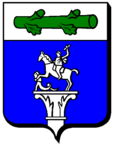Merten (Moselle)
| Merten | ||
|---|---|---|

|
|
|
| region | Grand Est | |
| Department | Moselle | |
| Arrondissement | Forbach-Boulay-Moselle | |
| Canton | Bouzonville | |
| Community association | Houve-Pays Boulageois | |
| Coordinates | 49 ° 15 ′ N , 6 ° 40 ′ E | |
| height | 196-305 m | |
| surface | 5.23 km 2 | |
| Residents | 1,504 (January 1, 2017) | |
| Population density | 288 inhabitants / km 2 | |
| Post Code | 57550 | |
| INSEE code | 57460 | |
 Church of the Visitation ( Église de la Visitation ) |
||
Merten ( Lorraine Méerten ) is a French commune with 1504 inhabitants (as of January 1, 2017) in the Moselle department in the Grand Est region ( Lorraine until 2016 ). It belongs to the Forbach-Boulay-Moselle arrondissement .
The inhabitants call themselves Mertenois . Their nicknames are "Die Klepperer", "Méertener Bésenbénner" and "Méertener Strépperten".
geography
The municipality of Merten borders the Saarland in the north and east , the Bist forms the eastern municipality boundary. The neighboring town on the German side is Bisten in the municipality of Überherrn .
history
Like the surrounding villages, Merten belonged to the German Bellistum of the Duchy of Lorraine until 1751 . When the provinces of the Ancien Régime were dissolved after the French Revolution , the region became part of the Moselle department . After Napoleon's defeat, Merten - like its neighboring town of Bisten - came to the Prussian district of Saarlouis .
In a border convention between Prussia and France that was drawn up in Paris on June 11, 1827 and confirmed in Saarbrücken on October 23, 1829 , there was a change in territory, in which Merten became French again.
Population development
| year | 1962 | 1968 | 1975 | 1982 | 1990 | 1999 | 2007 |
| Residents | 1,133 | 1,467 | 1,706 | 1,668 | 1,598 | 1,597 | 1,471 |
Worth seeing
At Christmas time each year, the choir of the Merten church is transformed into a huge nativity scene that attracts numerous visitors. Lighting, music and moving scenes can be switched on by inserting a coin.
Excavation finds
In 1878 an almost completely preserved Jupiter giant column was found during excavation work in Merten . It shows the Roman god Jupiter riding down a giant . The components of the column were purchased by the Metz Museum in 1879 , where they were restored and exhibited in 1885. The giant column of Jupiter in Merten was probably erected in the late 3rd century AD near a country estate to ensure protection and prosperity. Giant columns of Jupiter usually stood at crossroads, in fields, but mainly near Roman settlements, homesteads and in temple districts, mostly connected with a small enclosure and an altar in honor of the god Jupiter. It was there that sacrifices were made to the protector of the arable land, the harvest and the farm.
The base of the religious monument of Merten shows the deities Juno , Minerva , Apollo and the hero Hercules . The capital is decorated with allegories of the seasons. Such columns from the second and third centuries are particularly known from the eastern Gaulish provinces of the Roman Empire , between the Moselle and the Rhine . They represent a Gallo-Roman new creation. Celtic and Roman beliefs were connected with one another. The Celtic god of heaven and fertility was merged with the Roman father of gods Jupiter. The model for the giant columns of Jupiter was probably a large column in Mainz , which was erected in the years 59 to 60 AD. Towards the end of the first century, the later typical representation developed from this, in which an armored Jupiter crushes a snake-legged giant (Anguiped) while riding.
The base of these pillars is a mostly square pedestal adorned with images of gods, the so-called stone of the four gods . The gods depicted are mostly Juno, Mercury , Minerva and Hercules. This combination is derived from a representation in the Temple of Jupiter on the Capitol in Rome , where the father of gods is enthroned in the middle and flanked on his right by Minerva and Hercules and on his left by Juno and Mercury. In some cases, such as in Merten, the base is followed by a second, octagonal stone with reliefs of the planetary gods , which symbolize the individual days of the week . The actual column shaft rises above a cornice. The conclusion is formed by a capital with a group of riders: Jupiter on horseback and with lightning in his hand rides over a giant. This group of sculptures symbolizes the victory of the sky god over earthly chaos. While the height of the usual columns usually ranges from 3.5 m to 10.0 m, the Merten column was originally almost 15 m high.
A copy of the column was placed on February 10, 1989 in Rue Serpenoise in Metz.
Web links
Individual evidence
- ^ Passé-Présent, La Moselle dévoilée, n ° 4, Novembre-Décembre 2011.
- ↑ Gau un Griis - Merten
- ^ M. de Chastellux: Le territoire du département de la Moselle. 1860, pp. 202-203.
- ↑ Suzanne Braun: Metz, Portrait d´une ville, Metz 2008, pp. 12-13.

